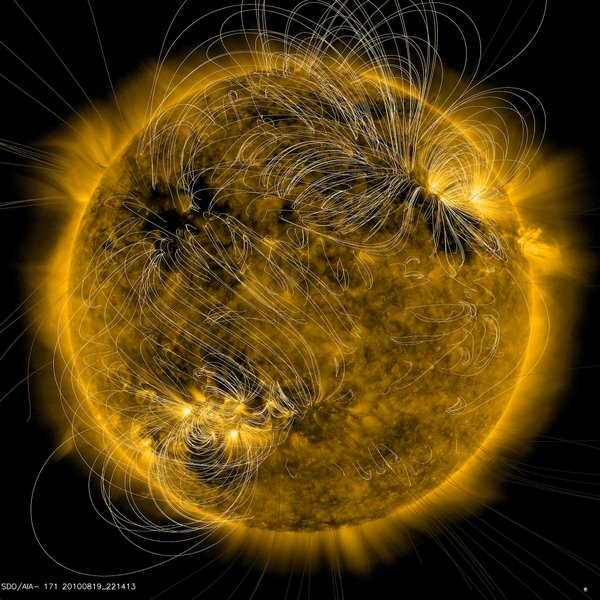[/caption]
The Sun’s corona is threaded with a complex network of magnetic fields, and this amazing new image from the Solar Dynamics Observatory shows the magnetic field lines associated with a coronal hole that is now turning to face Earth. This map is from data taken on August 20, 2010 by the Helioseismic and Magnetic Imager instrument (HMI). The magnetic field lines are color coded: white lines show fields that are closed, not releasing solar wind, and gold lines show open fields, letting solar wind escape. Understanding these magnetic fields is important because it is thought that solar storms and flares, which can affect us here on Earth, result from changes in the structure and connections of these fields.
Coronal holes are large regions in the corona that are darker, less dense and cooler than surrounding areas. The open structure of their magnetic field allows a constant flow of high-density plasma to stream out of the holes. There is an increase in the intensity of the solar wind effects on Earth when a coronal hole faces.
During a solar minimum, such as the one from which the Sun is just emerging, coronal holes are mainly found at the Sun’s polar regions, but they can be located anywhere on the sun during solar maximum. The fast-moving component of the solar wind is known to travel along open magnetic field lines that pass through coronal holes.
Scientists are finding out that much of the structure of the Sun’s corona is shaped by the magnetic field. Although it varies over time and from place to place on the Sun, the Sun’s magnetic field can be very strong. Inside sunspots, the magnetic field can be several thousand times the strength of the Earth’s magnetic field.
Learn more about magnetic field lines and how SDO’s HMI instrument will help us to better understand the Sun in this video from SDO:
More info: HMI webpage, SDO website
Sources: @Camilla_SDO Twitpic page, SDO Facebook, Solar Physics page from Montana University


I find it somewhat puzzling how a magnetic field line can be mapped without there being some plasma being carried along with it. After all, the SDO is not inserting a Hall probe in the solar magnetic field. The arches and solar prominences carry ionized gas and charged particles with them, where these can form a sort of map and the mass of the solar material (mostly hydrogen) can be used to estimate the field strength. Without that optical signature it strikes me as difficult to estimate what the fields are.
LC
The instrument that maps magnetic field lines is called the Helopseismic and Magnetic Imager: http://hmi.stanford.edu/Description/hmi-overview/hmi-overview.html
“how a magnetic field line can be mapped without there being some plasma ”
Lawrence, I’m not sure I understand. The image you may refer to, the first above, seems to be a composite of an SDO “AIA” instrument and a model based on HMI data. The HMI seems to be observing the Fe I 617.3 nm absorption line. That means there must be some Fe ions to look at at least partly along the modeled field.
Yup, there is an SDO AIA:
“AIA (Atmospheric Imaging Assembly)
The Atmospheric Imaging Assembly images the solar atmosphere in multiple wavelengths to link changes in the surface to interior changes. Data includes images of the Sun in 10 wavelengths every 10 seconds.”
The descriptions of the helioseismic imager still leaves me wondering about the model dependencies assumed. This amounts to taking various optical signatures of events on the sun an backing out this complicated MHD physics.
LC
Robert L Oldershaw says that every discrete particle class has a self-similar analogue at all other scales. our sun is an analogue to the ionic core of a lithium atom that has its outermost electron in a very excited state: n=168, l=160, m~l . Galactic sizes, shapes, masses, and rotational behaviors fit the nuclei analogy for galaxies too. I wanted to know if this is valid science for the layman to be amazed with. It seems incredible that a giant lithium atom of atomic number 3 would be a scale analogue of nature that is our sun. the magnetic fields could be caused by the outermost electron??
Live and learn… tvist and turn! Some rather HOT data coming in from SDO. Yah GOTTA like it! HO! Definitely in the top ten list of missions to pay attention to! I rate it right up there at #3 behind the Cassini and MRO/Rover missions. #4 might be the LRO? But it keeps sliding back and forth to the number one spot! Tough to say, as each one contributes amazing new science for us to ponder!
Remember, paradigm changes are difficult, but well worth the effort! Besides, learning something new always seems to breathe new life into us as we ‘inhale’ the knowledge then wisdom…